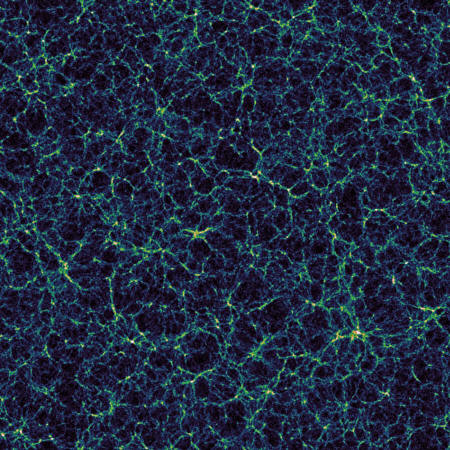|
shows the vast cosmic web of galaxies, as well as
the dark, empty
expanses of the cosmic voids in between.
courtesy of The Ohio
State University
By analyzing the giant voids of the cosmos, scientists now have more precise maps of matter in the universe, a new study finds (Constraints on Cosmology and Gravity from the Dynamics of Voids).
This strategy of looking at what's not there (as opposed to what's actually present) might help solve cosmic mysteries such as the nature of dark matter and dark energy, and whether or not extra forces of the universe exist, scientists added.
Astronomy mostly focuses on what telescopes can see - everything from stars to planets to moons to asteroids and comets.
However, previous research discovered that the universe is mostly composed of large, relatively empty domains known as cosmic voids, while galaxies are mostly scattered across the boundaries of these voids, forming a vast cosmic web.
This pattern of voids and clusters, strings and sheets of galaxies originated with fluctuations in the density of matter when the universe was young and small, which magnified as the universe expanded.
However, voids are not completely empty space.
For one thing,
In addition, just like matter-dominated parts of the universe, voids are permeated by dark matter, the invisible substance that prior work suggested makes up five-sixths of all the matter in the universe (below video), and influenced by dark energy, which is driving the accelerating expansion of the universe, Nico Hamaus said:
Looking into the void
In the new study, researchers examined data from the Sloan Digital Sky Survey (SDSS) to analyze the gravitational effects that matter surrounding voids had on the voids.
The computer simulations they developed focused on how the voids expanded and grew emptier over the eons.
Specifically, the scientists wanted to see if the way that voids changed over time deviated from predictions made by Einstein's general theory of relativity, the 'best' explanation so far of how gravity works.
Such discrepancies could point the way to better theories of gravity, and perhaps help solve cosmic mysteries, such as why the universe's expansion is accelerating.
The universe and everything within it began flying apart since the 'Big Bang.'
Although one might expect that the gravitational pull of all the matter in the cosmos would gradually slow down this expansion, either halting it or even collapsing everything back together in a "Big Crunch," but astronomers instead see that the galaxies are rushing apart faster and faster.
Many physicists currently blame this acceleration on dark energy, saying that it could make up more than 70 percent of the cosmos.
However, so much remains unknown about dark energy that some researchers wonder if it exists at all, and instead suggest alternative models of gravity that could explain these findings.
Don't avoid the void
Taking voids into account led to a fourfold boost in precision regarding measurements of how the universe's visible matter is clustered together, the researchers said.
Paul Sutter likened their new technique to learning more about Swiss cheese by studying the holes.
The new findings did not find any conflicts with Einstein's theory of gravity.
Future research can gather more data about voids and develop more accurate models of void behavior to help solve cosmic mysteries, Hamaus said.
For example, analyzing void behavior could shed light on the nature of the particles that might make up dark matter, such as whether they are relatively fast-moving or not, Hamaus said.
The scientists detailed their findings in a paper (Constraints on Cosmology and Gravity from the Dynamics of Voids) accepted online July 26 by the journal Physical Review Letters.
|


